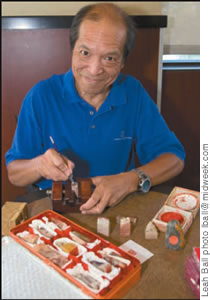The Ancient Art Of Chinese Seals

By .(JavaScript must be enabled to view this email address)
| Share
 Del.icio.us
Del.icio.us
|
In the days of instant messages, e-mails and digital signatures, Stephen Kow continues the fine art of hand-carving Chinese seals. The seal has a decorative design such as a dragon on top of the square stone, and the bottom is placed in ink to make a unique impression.
“Imperial documents would have the emperor’s seal on them,” explains Kow, who carves seals at his Kalihi home. “If a messenger hands you a document with an imperial seal, then you’d better follow the order - or else.”
With his company, China Seal Artists, Kow makes seals that are used in a modern-day way where artists sometimes sign their name in English on their work alongside their seal.
“Today, any government agency in Hong Kong or China uses the seal still,” the Farrington High School graduate says. “In banks in Japan, I heard you can’t cash a check unless you have your seal with you. So the seal is like a double check. It’s still used for authentication and legal documents.”
For Chinese New Year and other Chinese Chamber of Commerce functions, Kow, an educational specialist with the Department of Education, shares what he knows about the history and the art of seal-making.
This weekend, at the annual Splendor of China Cultural Festival and Tradeshow at Neal Blaisdell Exhibition Hall from 10 a.m. to 9 p.m. Saturday and 10 a.m. to 5 p.m. Sunday, he’ll have a booth where he will present interactive, hands-on demonstrations on how to make a seal. He’ll provide attendees soft gum rubber erasers and a linoleum knife so they can create a simple seal in 15-20 minutes. He copies a drawing on the eraser, and the attendee carves it.
For the real seals, Kow uses soapstones, and he does his best to ensure they are historically accurate by using the oldest of the 3,000-year-old Chinese characters instead of modern ones. He notes the seal needs to be strong, clear, flexible, and have a balance between white and red. Seals are often carefully packed away in their own special container.
To make personal seals, Kow gets to know the person by asking them things like what he or she will use the seal for, and what is important the person’s life.
“If you look at a seal, it gives you the feeling of life-giving energy,” says Kow. “In a half -inch square of space you want to reflect a whole person.”
Kow went to Chinese school as a youngster, where he learned calligraphy with pen and brush. He continued his education with Chinese culture classes at the University of Hawaii. He started engraving seals in the early 1970s when he was so fascinated by seeing them that he wanted one. No one in Hawaii made them, but it just so happened that one of his teachers had a seal-making instruction book, and another friend had the necessary materials.
“I liked it so much that I looked for other sources of stones,” Kow recalls. “Because of my interest in culture, I was taking trips to Asia and visiting seals specialty shops in Hong Kong. I had to support my habit of buying stones, and so I made seals for others.”
With the support of his wife, Iris Lin, and their son, Alex, he hopes to continue educating as many people as possible about the seals.
“To see children get interested in it, that’s my enjoyment,” he says.
To learn more about Chinese seal engraving, Kow recommends Googling “Thinkquest Chinese Seals.”
For more information, call 230-7086 or e-mail .(JavaScript must be enabled to view this email address).
E-mail this story | Print this page | Comments (0) | Archive | RSS Comments (0) |
Most Recent Comment(s):













